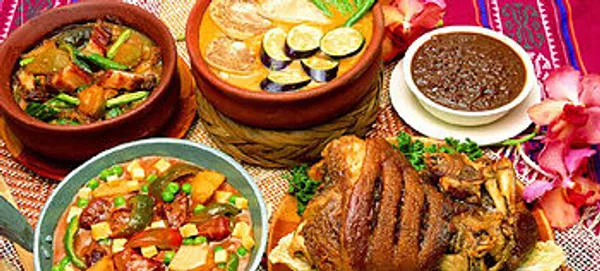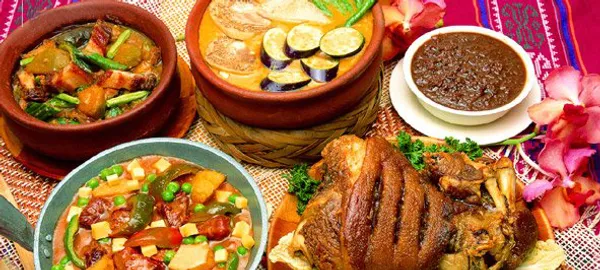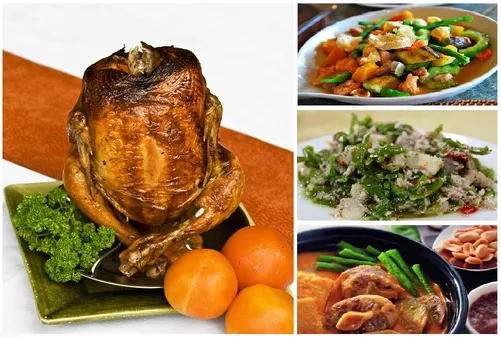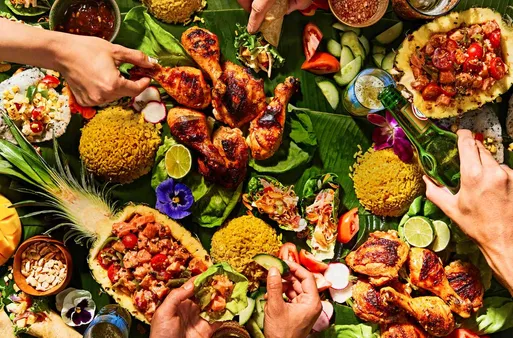Table of Contents
Embark on a culinary journey through the diverse regional cuisines of the Philippines. From the vibrant streets of Manila to the tranquil shores of Palawan, each region offers a unique symphony of flavors that reflects its rich cultural heritage. Discover the distinct dishes, cooking techniques, and local ingredients that define the regional cuisines of Northern Luzon, Central Luzon, Southern Tagalog, the Visayas, Mindanao, and Palawan. Join us on Tauhuichiban.com as we unveil the hidden gems and unparalleled flavors that await in every corner of this gastronomic paradise. Prepare your taste buds for an extraordinary adventure as we explore The differences between regional cuisines in the Philippines.

The Differences Between Regional Cuisines in the Philippines: A Culinary Journey Through the Archipelago
I. Regional Cuisines in the Philippines: A Journey Through Diverse Flavors
The Philippines is a melting pot of cultures, and this is reflected in its cuisine. Each region of the country has its own unique dishes, flavors, and cooking techniques. In this article, we will take a journey through the diverse regional cuisines of the Philippines, exploring the unique flavors and ingredients that make each region special.
We will start our journey in the northernmost region of Luzon. The cuisine of Luzon is heavily influenced by Chinese and Spanish cuisine, and is known for its use of soy sauce, garlic, and onions. Some of the most popular dishes from Luzon include adobo, kare-kare, and sinigang.
Dish | Description |
|---|---|
Adobo | A stew made with pork or chicken, soy sauce, vinegar, garlic, and onions. |
Kare-kare | A stew made with oxtail, vegetables, and peanut sauce. |
Sinigang | A sour soup made with pork or fish, vegetables, and tamarind. |
Next, we will travel to the central region of the Philippines, known as the Visayas. The cuisine of the Visayas is known for its use of seafood, coconut milk, and spices. Some of the most popular dishes from the Visayas include lechon, kinilaw, and sinugba.
Dish | Description |
|---|---|
Lechon | A roasted pig, often served with a dipping sauce made from vinegar, garlic, and onions. |
Kinilaw | A raw fish salad made with vinegar, onions, and chili peppers. |
Sinugba | A grilled fish dish, often served with a dipping sauce made from vinegar, garlic, and onions. |
Finally, we will travel to the southernmost region of the Philippines, known as Mindanao. The cuisine of Mindanao is known for its use of spices, coconut milk, and seafood. Some of the most popular dishes from Mindanao include rendang, satay, and nasi goreng.
Dish | Description |
|---|---|
Rendang | A spicy beef stew made with coconut milk, spices, and herbs. |
Satay | Grilled meat skewers, often served with a peanut sauce. |
Nasi goreng | A fried rice dish made with vegetables, meat, and eggs. |
The regional cuisines of the Philippines are as diverse as the country itself. Each region has its own unique flavors and ingredients, and each dish tells a story about the history and culture of the region. Whether you are a local or a visitor, there is sure to be a regional cuisine in the Philippines that you will love.
Here are some additional tips for exploring the regional cuisines of the Philippines:
- Be adventurous and try new dishes.
- Ask locals for recommendations.
- Visit local markets and food stalls.
- Take a cooking class.
- Read about the history and culture of the Philippines.
By following these tips, you can immerse yourself in the rich and diverse culinary traditions of the Philippines.

Regional Cuisines in the Philippines: A Journey Through Diverse Flavors
II. Luzon's Culinary Treasures: A Blend of Influences
The northern landscapes of Luzon, the largest island in the Philippines, unfold a tapestry of vibrant flavors and culinary traditions derived from its diverse ethnic groups. Steeped in history and rich in natural resources, the region offers a unique blend of indigenous, Spanish, and Chinese influences that have shaped its distinctive cuisine.
In the heart of the Ilocos region, for instance, the use of fermented rice in dishes such as “pinapaitan” (bitter gourd soup) and “dinengdeng” (vegetable stew) adds a sour and savory dimension to the local palate. Further south in the Pangasinan province, delectable seafood takes center stage, evident in the renowned “bangus” (milkfish) dishes prepared in myriad ways.
Dish | Description |
|---|---|
Pinapaitan | A bitter gourd soup made with pork or goat, tamarind, and various vegetables |
Dinengdeng | A vegetable stew made with various seasonal vegetables, tomatoes, and fermented rice |
Bangus Sisig | A sizzling dish made with chopped milkfish, onions, and chili peppers |
The influence of Spanish colonizers is also evident in the cuisine of Luzon. “Kare-kare” (oxtail stew), a popular dish in the central Luzon region, combines indigenous ingredients like oxtail and vegetables with the Western introduction of peanut sauce. The use of garlic and onions, a staple in Spanish cooking, is also prevalent in many local dishes.
Chinese settlers have further enriched the culinary landscape of Luzon. Dishes like “pancit” (noodles), “lumpia” (spring rolls), and “siomai” (dumplings) are now an integral part of the region's gastronomic identity. The Chinese emphasis on balance and harmony of flavors has also influenced the preparation of traditional Filipino dishes.
III. The Visayas: A Melting Pot of Culinary Delights
The Visayas, a group of islands in the central Philippines, is a melting pot of culinary delights. The region's cuisine is influenced by a variety of cultures, including Malay, Chinese, Spanish, and American. As a result, the Visayas offers a wide range of dishes, from simple street food to elaborate feasts.
One of the most popular dishes in the Visayas is lechon, a whole roasted pig. Lechon is typically served at special occasions, such as weddings and fiestas. Another popular dish is sinigang, a sour soup made with pork, vegetables, and tamarind. Sinigang is often served with rice and is a favorite comfort food for many Filipinos.
Dish | Description |
|---|---|
Lechon | A whole roasted pig |
Sinigang | A sour soup made with pork, vegetables, and tamarind |
Adobo | A stew made with pork or chicken, soy sauce, vinegar, and garlic |
Kare-kare | A peanut-based stew made with oxtail, vegetables, and shrimp paste |
Pancit | A noodle dish made with stir-fried noodles, vegetables, and meat |
In addition to these traditional dishes, the Visayas is also home to a number of unique regional specialties. For example, the island of Bohol is known for its chicken inasal, a grilled chicken dish that is marinated in a mixture of annatto, garlic, and vinegar. The island of Cebu is known for its lechon Cebu, a version of lechon that is roasted over charcoal and has a crispy skin.
No matter what your taste, you're sure to find something to love in the Visayas. The region's cuisine is a reflection of its rich culture and history, and it offers a unique and delicious experience for visitors from all over the world.

The Visayas: A Melting Pot of Culinary Delights
IV. Mindanao's Exotic Flavors: A Taste of Adventure
The southernmost region of the Philippines, Mindanao, is a melting pot of cultures and flavors. From the vibrant street food of Davao to the traditional cuisine of the Maranao people, Mindanao offers a diverse culinary landscape that is sure to tantalize your taste buds.
One of the most popular dishes in Mindanao is kinilaw, a raw fish salad that is marinated in vinegar, chili peppers, and onions. Kinilaw is often served with rice or grilled fish and is a refreshing and flavorful way to start a meal. Discover the diverse culinary traditions of the Philippines
Dish | Description |
|---|---|
Kinilaw | Raw fish salad marinated in vinegar, chili peppers, and onions |
Sinuglaw | Grilled pork and fish marinated in vinegar, chili peppers, and onions |
Piyaya | Sweet pastry filled with mung beans and coconut |
Another popular dish in Mindanao is sinuglaw, which is a grilled pork and fish dish that is marinated in vinegar, chili peppers, and onions. Sinuglaw is often served with rice or grilled vegetables and is a hearty and flavorful dish that is perfect for a main course.
For dessert, be sure to try piyaya, a sweet pastry that is filled with mung beans and coconut. Piyaya is a popular snack food in Mindanao and is often served with coffee or tea. Explore the top-rated Filipino restaurants in your area
If you are looking for a truly unique and authentic dining experience, be sure to visit Mindanao. The region's diverse culinary landscape is sure to offer something to please everyone.

Mindanao's Exotic Flavors: A Taste of Adventure
V. Conclusion
The regional cuisines of the Philippines are a testament to the country's rich cultural heritage and diverse culinary traditions. From the hearty dishes of Northern Luzon to the seafood-centric cuisine of the Visayas, each region offers a unique and unforgettable culinary experience. Whether you're a seasoned foodie or simply curious about exploring new flavors, the Philippines is a culinary destination that will tantalize your taste buds and leave you craving for more. Embrace the opportunity to immerse yourself in the local culture and traditions through the diverse regional cuisines of the Philippines. From bustling street food markets to fine dining establishments, there's something for every palate to savor. So, embark on a culinary adventure and discover the hidden gems and unparalleled flavors that await in each region of this gastronomic paradise.